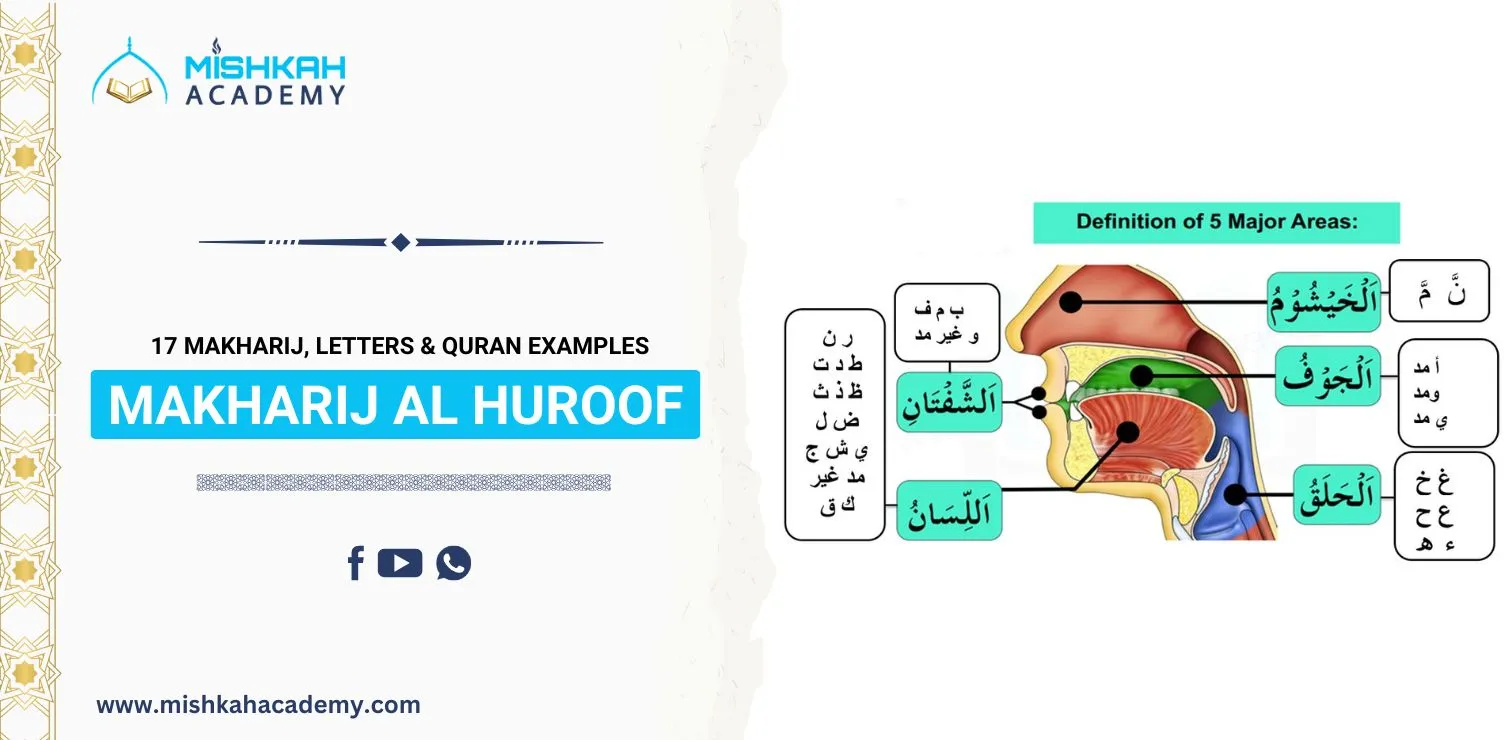Makharij Al Haruf is one of the most important principles in Arabic grammar. Makharij (Arabic مخارج) is a term used to refer to the correct production of Arabic letters. It translates as “exit points” and refers to the positions of the mouth, tongue, and lips used to produce different sounds correctly.
What is Makharij al-Huroof?
Table of Contents
ToggleOne of the most important ideas in Tajweed, the science of correct Quranic recitation, is Makharij al-Huroof. The articulation points from which each Arabic letter sounds are referred to by this name. Correct pronunciation and conservation of the purity of the Quranic recitation as revealed to the Prophet Muhammad (PBUH) are guaranteed by mastering makharij. Word meanings can shift when makharij are ignored, which can result in serious misunderstandings of Quranic texts.
Definition of Makharij al-Huroof
“خرج” is the Arabic root word that means “to exit,” and this is where the word makharij (مخارج) comes. It describes the precise location from which a sound “exits” or is pronounced during recitation. Every one of the twenty-eight Arabic letters has an unique joint point known as its makhraj (singular form of makharij).
Makharij al-Huroof, thus, describes exactly where in the mouth, throat, or chest from which the sound of each letter comes. This is crucial since Arabic characters are highly prone to even minute articulation errors. Words can have several meanings when they are mispronounced, particularly in the Quran.
Makharij And Sifaat
Makharij is the place of articulation for producing sound, and sifaat refers to the characteristics of the sounds produced. For example, the makharij for making an ‘h’ sound is from deep in the throat, while its sifaat may include being aspirated (a small puff of air accompanying it).
Knowing how to articulate and pronounce sounds accurately is key to achieving high fluency in Arabic. Learning about makharij and sifaat can also be useful for understanding how the language works, particularly when combining letters into words.
Why is Tajweed’s Makharij Important?
The proper pronunciation of Arabic letters and their features are basic to the study of Tajweed. Keeping the beauty, sound, and accuracy of Quranic recitation is the main aim of Tajweed. The significance of makharij is seen in its ability to maintain the Quran’s original tone, exactly as it was revealed.
Word meanings might alter significantly if one fails to distinguish between letters that have similar sounds, such as “ض” (Daad) and “ظ” (Zhaa). For this reason, knowing makharij is essential to accurately reciting the Quran.
Note: To learn Makhraj proper enroll in an advance tajweed course with professional tajweed tutors.
Makharij of Arabic Letters
The Five Principal Areas
- Al-Jawf – The Interior/Chest Area
- Al-Halq –The Throat
- Al-Lisaan –The Tongue
- Al-Shafataan – The Lips
- Al-Khayshoom – The Nasal Passage
Tajweed scholars have divided the makharij into five main vocal system zones in humans:
1. Al-Jawf (the space in the throat and mouth)
This region, often known as the empty gap, is where the three Arabic long vowels (Madd letters) developed.
- ا Alif Madd: is spoken without making contact with the lips or tongue.
- و (Waw Madd): Air moving between the lips and pronouncing it with an empty space.
- ي (Ya Madd): Flowing with a relaxed tongue through the empty space.
2. Al-Halq, (The Throat)
Three regions make up the throat, and it is from these that six letters originate:
From the base of the throat come the words
- أ (Hamzah) and هـ (Haa).
- ع (Ayn) and ح (Haa):: From the throat’s center.
- غ (Ghain) and خ (Khaa): From the throat’s top part.
3. Al-Lisaan,”The Tongue,“
It is the greatest area of articulation, consisting of eighteen letters that come from different parts of the tongue:
- The Root of the Tongue: Depending on how far the tongue goes into the soft palate, it produces letters like ق (Qaaf) and ك
- The Tongue’s Midsection: Here, letters like ش (Sheen), ج (Jeem), and ي (Ya) are expressed.
- The tongue’s sides: To pronounce the letter ض (Daad), press the sides of your tongue against your molars.
- Tipping the Tongue: A number of letters are articulated with the tongue tip either touching or close to the front teeth, including ت (Taa), د (Daal), س (Seen), ص (Saad), ز (Zay), and ث (Thaa)
4. Ash-Shafataan, “The Lips“
Four letters are produced by the lips:
- ف (Faa): Speak by pressing your upper teeth against your lower lip.
- The mouth movements for ب (Baa), م (Meem), and و (Waw): are lips that are closed or rounded.
5. Al-Khaishoom, The Nasal Cavity
Although there isn’t a single letter that comes from the nasal cavity, it is the source of the nasal sounds made when pronouncing the letters م (Meem) and ن (Noon), as part of the process of nasalization.
List of the 17 Makharij
The term “makhrij” describes the articulation sites for Arabic letter sounds. Understanding makharij is crucial for perfect pronunciation and Quranic recitation since it guarantees the distinct and precise pronunciation of every letter. The 17 primary makharij, which are associated with individual letters, can be divided into various zones according to where they are located in the mouth and throat.
- Al-Jawf, The Mouth’s Empty Space: This is the area of the oral cavity that creates vowel sounds, especially the extended (madd) letters ا (Alif), و (Waw), and ي (Ya)
- Al-Halq, The Oral Organ: ء (Hamzah) and هـ (Haa) are produced by the Aqsal-Halq (Deepest Part). In the middle of the throat, or Wasat al-Halq, ع (Ayn) and ح (Haa).are produced. غ (Ghain) and خ (Khaa) are produced in Adnal-Halq (upper part).
- Al-Lisaan, The Speech: A base that touches the soft palate yields ق (Qaaf). When the Hard Palate is touched, the base produces ك (Kaaf). Middle of the Tongue: Produces ج (Jeem) and ش (Sheen), along with ي (Ya non-madd). Tongue Side: Generatesض (Daad). A border with upper gums: generates a ل (Laam). Advice for Upper Gums: Generates ن (Noon). Produces ر (Raa) when the tip of the mouth is used. Point Close to Upper Teeth: Generates ت (Taa), د (Daal), and ط (Taa emphatic). Produces ث (Thaa), ذ (Dhaal), and ظ (Zhaa) at the tip of the teeth. Produces when tipped near the gums س (Seen), ص (Saad), and ز (Zay).
- The Two Lips, Ash-Shafatain: Produces ف (Faa) inside the lower lip with the upper teeth. With both lips shut, ب (Baa) and م (Meem) are produced. Unclosed Rounded Lips: Generatesو (Waw non-madd).
- Al-Kaikh, often known as “The Roof of the Mouth,” is necessary to make specific noises.
- Al-Isthnaa, or the upper gum: Allows speech.
- Nasal noises are related to Al-Inbithar, or the Nasal Cavity.
- The nasal passage, or Al-Ikhfaa, plays a role in producing sounds that reverberate within the nasal cavity.
- The Palate, or Al-Khayshoom, is involved in articulation.
- Al-Lahhah (The Tongue’s Sides): Improves the quality of sound.
- Al-Rihawah (The Molars): Gives pronunciation more nuance.
- Al-Ghunnah, also known as “The Nasal Sound,” describes the nasal aspect of several letters.
- Al-Ikhfaa Shafawi: Also known as The Hidden Shafawi: It deals with particular sound production.
- Al-Istifal, also known as The Lower Lip: Participates in certain letters.
- Al-Anbar, or the upper lip: Aids in the articulation of sounds.
- Al-Khitaan (The Circumcision): Regarding phonetic aspects.
- Al-Tafasil, or “The Gaps Between the Teeth,” is crucial to the understanding of some sounds.
Learn 17 Makharij properly by enrolling in quran tajweed course with experienced tajweed tutors.
What is Makharij in the Quran?
It is extremely important to remember Makharij al-Huroof when reciting the Quran. Arabic is a language with exact and delicate sounds that, if mispronounced, can change meanings. This language is used to reveal the Quran. Understanding and using makharij when reciting the Quran guarantees that each letter is spoken at the proper place of articulation.
Makharij Examples
It is the duty of individuals who wish to recite the Quran with accuracy to perfect its pronunciation according to makharij, as it is a spiritual act of worship. In Surah Al-Muzzammil (73:4), Allah (SWT) gives the order, “And recite the Quran with measured recitation.” This is about following by the laws of Tajweed, of which makharij is a vital part.
For example, mispronouncing a letter such as ص (Saad) as س might result in major changes. Therefore, maintaining the sanctity and significance of Allah’s words during the recitation of the Quran depends on paying close attention to makharij. Tajweed experts stress that practicing and mastering makharij involves respecting the divine voice in addition to mastering technical accuracy.
A Muslim can make sure they are following the order to recite the Quran in a clear, correct, and attractive way by being skilled in makharij.
Guidelines for Pronouncing Makharij Correctly
There are a few guidelines that must be followed in order to achieve flawless pronunciation and clarity:
- Recognize the Makharij: Knowing the starting place from which each letter should be pronounced is the first step. To do this, you must practice under a teacher’s supervision and pay attention to experienced Qaris.
- Steer clear of Overlapping Sounds: Certain letters, like س (Seen) and ث (Thaa). , have remarkably similar positions of articulation. To prevent meanings from changing, it’s imperative to keep these letters distinct from one another.
- Correcting Common Errors: Because of their original language, some non-Arabic speakers frequently pronounce letters at incorrect positions. For instance, people frequently mix the Arabic letter ض (Daad) with د (Daal). These problems can be fixed with consistent practice using proper articulation.
- Recognize Characteristics of Letters (Sifaat al-Huroof): The pronunciation of each Arabic letter is complemented by its power, softness, and heaviness. Appropriate articulation is ensured by balancing these characteristics and using makharij.
Conclusion
It is important to understand makharij in order to recite the Quran correctly. Accurately communicating the message of the Quran requires accurate pronunciation, which can only be achieved via mastery of these pronunciation points. Learning makharij al haroof can be difficult, but it is an important part of learning Arabic. With enough practice and guidance from a qualified teacher, such as those at Mishkah Academy through our Online Quran Recitation Course, students can become more proficient in their pronunciation and intonation, leading to higher fluency in the language.
Understanding the makharij al haroof will provide insight into the nuances of different dialects of Arabic and allow students to recognize the minor differences between similar-sounding letters and words. With enough effort, you can master the makharij al haroof and become an expert in the Arabic language with the support of Mishkah Academy.






